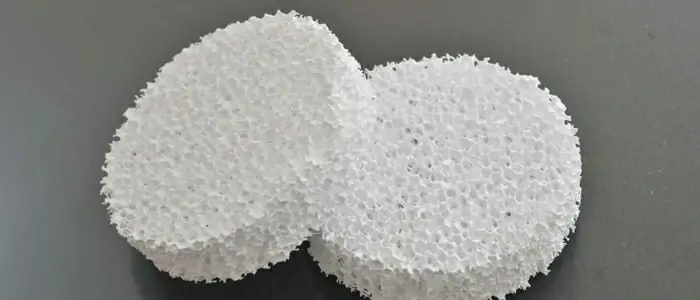Foam ceramics are a class of highly porous materials that combine the inherent properties of ceramics—like high-temperature resistance, chemical stability, and structural strength—with the unique benefits of a foam structure, such as low density, high surface area, and excellent thermal insulation. These properties make them indispensable in a wide range of industrial applications, including filters for molten metals, thermal insulation linings, catalytic substrates, and porous burners.
The manufacturing process primarily revolves around creating a gaseous phase within a ceramic matrix. The two most prevalent methods for achieving this are the Polymer Sponge Replication Method and the Direct Foaming Method. This article provides a detailed, step-by-step explanation of these processes.
Method 1: The Polymer Sponge Replication Method
This is the most established and widely used industrial technique for producing open-cell foam ceramics. It involves using a sacrificial polymer template to define the porous structure.
Required Materials and Equipment:
-
Ceramic Powder: The base material (e.g., Alumina (Al₂O₃), Zirconia (ZrO₂), Silicon Carbide (SiC), Cordierite).
-
Polyurethane (PU) Foam: Open-cell foam with a specific pore size, measured in Pores Per Inch (PPI) (typically 10-60 PPI). This acts as the sacrificial template.
-
Binder: (e.g., Polyvinyl Alcohol (PVA), Methylcellulose) to provide strength before sintering.
-
Dispersant: (e.g., Dolapix) to de-agglomerate powder particles and ensure a stable, homogeneous slurry.
-
Plasticizer: (e.g., Glycerol) to add flexibility to the dried coating and prevent cracking.
-
Ball Mill or High-Shear Mixer: For preparing the slurry.
-
Programmable Kiln: A furnace capable of controlled heating and cooling cycles is essential.
Step-by-Step Process:
-
Slurry Preparation:
The goal is to create a smooth, homogeneous slurry with the viscosity of heavy cream. Combine deionized water and the dispersant with the ceramic powder in a ball mill. Milling ensures all particle agglomerates are broken down. Subsequently, the binder and plasticizer are added and mixed thoroughly. The slurry must be fluid enough to infiltrate the foam but viscous enough to coat the struts thickly without clogging the pores. -
Template Preparation:
The polyurethane foam is cut to the desired shape and size. It is often beneficial to lightly compress and clean the foam to open up its network and remove any manufacturing residues, ensuring better slurry penetration. -
Coating (Impregnation):
The PU foam is fully immersed into the ceramic slurry. Using rollers or a similar compression system, the foam is repeatedly squeezed to force the slurry into its entire network, coating all the struts. The excess slurry is then removed by passing the foam through rollers or by centrifuging. This step is critical to ensure the windows between pores remain open, guaranteeing interconnected porosity in the final product. -
Drying:
The coated foam is dried slowly at room temperature or slightly elevated temperatures (40-60°C). Rapid drying must be avoided, as it causes differential shrinkage and cracks in the ceramic coating. After drying, the part possesses sufficient “green strength” to be handled. -
Binder Burn-out (Pyrolysis):
This is the most critical thermal stage. The dried part is placed in a kiln and heated at a very slow rate (1-2°C per minute) through the temperature range of 200-500°C. During this phase, the polyurethane template thermally decomposes and volatilizes. A too-rapid heating rate will cause violent off-gassing, which will crack and destroy the fragile ceramic network. A hold at around 600°C ensures complete removal of all organic materials. -
Sintering:
After the organics are removed, the temperature is raised to the material-specific sintering temperature (e.g., ~1600°C for alumina, ~1200°C for cordierite). At this high temperature, diffusion processes cause the ceramic particles to fuse together, densifying the struts and creating a strong, rigid ceramic skeleton. The furnace is then cooled at a controlled rate to prevent thermal shock.

Result: A lightweight, rigid ceramic structure that is a perfect negative replica of the original polymer foam.
Method 2: The Direct Foaming Method
This technique involves generating gas bubbles directly within a ceramic slurry to create a foam, which is then solidified.
Key Materials:
-
Similar ceramic slurry components as Method 1.
-
Surfactant (Foaming Agent): (e.g., Triton X-100) to stabilize the generated gas bubbles.
-
Gelling Agent: (e.g., Gelatin) to rapidly set the foam’s structure.
Process Overview:
-
A ceramic slurry is prepared with the addition of a surfactant.
-
Air is introduced into the slurry through vigorous mechanical stirring (whisking) or by injecting an inert gas. This creates a wet, stable ceramic foam similar to a meringue.
-
A gelling agent (e.g., gelatin) is added, and the foam is cast into a mold. A change in temperature (cooling) triggers rapid gelation, “freezing” the bubble structure in place before it can collapse.
-
The gelled wet foam then undergoes a similar drying, burn-out, and sintering cycle as described in the replication method. Extra care is needed during drying due to the high initial water content.
Critical Parameters for Success
-
Slurry Rheology: The flow behavior of the slurry is the most crucial factor. It dictates the coating thickness, pore openness, and overall quality.
-
Controlled Thermal Cycles: Ramping the temperature too quickly during burn-out and sintering is the most common cause of failure. Precision kiln programming is non-negotiable.
-
Property Trade-off: A fundamental inverse relationship exists between porosity and mechanical strength. Higher porosity improves insulation but reduces load-bearing capacity. Strength can be optimized by using finer powders and adjusting sintering profiles to create denser struts.
Safety First: This process involves high-temperature equipment and fine ceramic dust, which are significant hazards. Always use appropriate Personal Protective Equipment (PPE) including heat-resistant gloves, safety glasses, and a respirator. The burn-out phase releases toxic fumes from the decomposing polymer and must be conducted in a well-ventilated area or a fume hood.
Summary
In summary, manufacturing foam ceramic is a sophisticated process centered on creating a stable, gaseous phase within a ceramic matrix. The two primary methods are the Polymer Sponge Replication Method—ideal for open-cell structures using a sacrificial polyurethane template—and the Direct Foaming Method—where gas bubbles are generated directly within a ceramic slurry. Success hinges on three critical pillars: precise slurry formulation for optimal rheology, meticulous control of the drying process to prevent cracking, and strictly programmed thermal cycles for safe binder removal and effective sintering. By mastering these processes, engineers can tailor these versatile high-performance materials for demanding applications in filtration, insulation, and catalysis.


